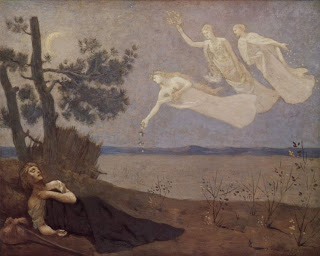Opinions about the meaning of dreams have varied and shifted through time and culture. Dream interpretations date back to 5000–4000 BC. The earliest recorded dreams were acquired from materials dating back approximately 5,000 years. In Mesopotamia, where they were documented on clay tablets. The Mesopotamians believed that the soul, or some part of it, moves out from the body of the sleeping person and actually visits the places and persons the dreamer sees in his sleep. Sometimes the god of dreams is said to carry the dreamer. Babylonians and Assyrians divided dreams into "good," which were sent by the gods, and "bad," sent by demons - They also believed that their dreams were omens and prophecies.
In Chinese history, people wrote of two vital aspects of the soul of which one is freed from the body during slumber to journey a dream realm, while the other remained in the body, although this belief and dream interpretation had been questioned since early times, such as by the philosopher Wang Chong. The Indian text Upanishads, written between 900 and 500 BC, emphasize two meanings on dreams. The first says that dreams are merely expressions of inner desires. The second is the belief of the soul leaving the body and being guided until awakened.
In the Greek and Roman periods, the people believed that dreams were direct messages from the gods or from the dead, and that they predicted the future. Some cultures practiced dream incubation with the intention of cultivating dreams that are prophetic. Antiphon wrote the first known Greek book on dreams in the 5th century BC. In that century, other cultures influenced Greeks to develop the belief that souls left the sleeping body.

In Judaism, dreams are considered part of the experience of the world that can be interpreted and that lessons can be garnered from. It is discussed in the Talmud, Tractate Berachot, Second Part. The ancient Hebrews connected their dreams heavily with their religion, though the Hebrews were monotheistic and believed that dreams were the voice of one god alone. Hebrews also differentiated between good dreams (from God) and bad dreams (from evil spirits). The Hebrews, like many other ancient cultures, incubated dreams in order to receive divine revelation. Christians for the most part shared their beliefs with the Hebrews and thought that dreams were of the supernatural element because the Old Testament had frequent stories of dreams with divine inspiration.
References to dreams in art are as old as literature itself: the story of Gilgamesh, the Bible, and the Iliad all describe dreams of major characters and the meanings thereof. However, dreams as art, without a "real" frame story, appear to be a later development—though there is no way to know whether many premodern works were dream-based. In European literature, the Romantic movement emphasized the value of emotion and irrational inspiration. "Visions", whether from dreams or intoxication, served as raw material and were taken to represent the artist's highest creative potential. In the late 19th and early 20th centuries, Symbolism and Expressionism introduced dream imagery into visual art. Expressionism was also a literary movement, and included the later work of the playwright August Strindberg, who coined the term "dream play" for a style of narrative that did not distinguish between fantasy and reality.